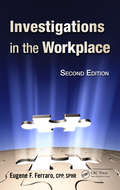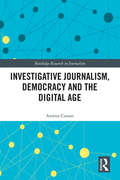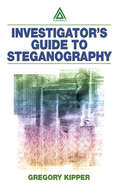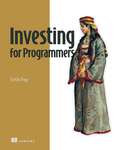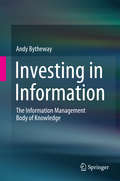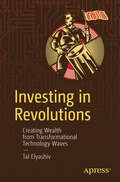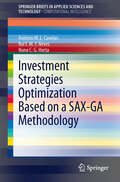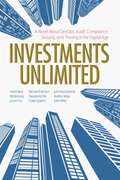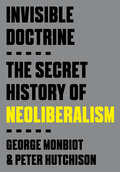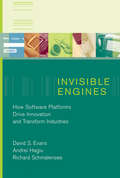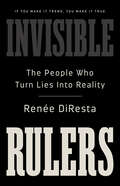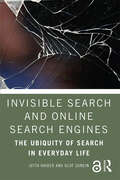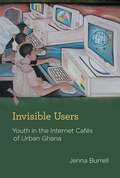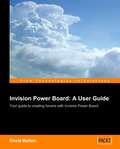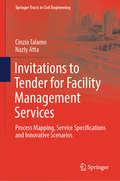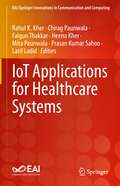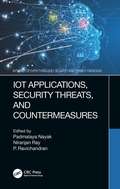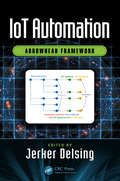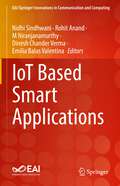- Table View
- List View
Investigations in the Workplace
by Eugene F. Ferraro Ban Seng Choo T.J. MacGinleyThe process of investigation is dynamic and fluid. The approach must be reasonable and the investigator flexible. However, in order to be successful, every investigation must have a meaningful purpose and be executed ethically and lawfully.Inevitably, employers must invest time, money, and patience to ensure they obtain demonstrable and actionable
Investigative Journalism, Democracy and the Digital Age (Routledge Research in Journalism)
by Andrea CarsonTheoretically grounded and using quantitative data spanning more than 50 years together with qualitative research, this book examines investigative journalism’s role in liberal democracies in the past and in the digital age. In its ideal form, investigative reporting provides a check on power in society and therefore can strengthen democratic accountability. The capacity is important to address now because the political and economic environment for journalism has changed substantially in recent decades. In particular, the commercialization of the Internet has disrupted the business model of traditional media outlets and the ways news content is gathered and disseminated. Despite these disruptions, this book’s central aim is to demonstrate using empirical research that investigative journalism is not in fact in decline in developed economies, as is often feared.
Investigator's Guide to Steganography
by Gregory KipperThe Investigator's Guide to Steganography provides a comprehensive look at this unique form of hidden communication from its beginnings to modern uses. It begins by exploring the past; providing insight into how this steganography began and evolved from ancient times to present day. It continues with an in-depth look at the workings of digital steganography and watermarking methods, available tools on the Internet, and the companies who are providing cutting edge steganography and watermarking services. The third section outlines real world uses of steganography. The book concludes by reviewing steganography detection methods and what can be expected in the future.
Investing for Programmers
by Stefan PappMaximize your portfolio, analyze markets, and make data-driven investment decisions using Python and generative AI.Investing for Programmers shows you how you can turn your existing skills as a programmer into a knack for making sharper investment choices. You&’ll learn how to use the Python ecosystem, modern analytic methods, and cutting-edge AI tools to make better decisions and improve the odds of long-term financial success. In Investing for Programmers you&’ll learn how to: • Build stock analysis tools and predictive models • Identify market-beating investment opportunities • Design and evaluate algorithmic trading strategies • Use AI to automate investment research • Analyze market sentiments with media data mining In Investing for Programmers you'll learn the basics of financial investment as you conduct real market analysis, connect with trading APIs to automate buy-sell, and develop a systematic approach to risk management. Don&’t worry—there&’s no dodgy financial advice or flimsy get-rich-quick schemes. Real-life examples help you build your own intuition about financial markets, and make better decisions for retirement, financial independence, and getting more from your hard-earned money. About the technology A programmer has a unique edge when it comes to investing. Using open-source Python libraries and AI tools, you can perform sophisticated analysis normally reserved for expensive financial professionals. This book guides you step-by-step through building your own stock analysis tools, forecasting models, and more so you can make smart, data-driven investment decisions. About the book Investing for Programmers shows you how to analyze investment opportunities using Python and machine learning. In this easy-to-read handbook, experienced algorithmic investor Stefan Papp shows you how to use Pandas, NumPy, and Matplotlib to dissect stock market data, uncover patterns, and build your own trading models. You&’ll also discover how to use AI agents and LLMs to enhance your financial research and decision-making process. What's inside • Build stock analysis tools and predictive models • Design algorithmic trading strategies • Use AI to automate investment research • Analyze market sentiment with media data mining About the reader For professional and hobbyist Python programmers with basic personal finance experience. About the author Stefan Papp combines 20 years of investment experience in stocks, cryptocurrency, and bonds with decades of work as a data engineer, architect, and software consultant. Table of Contents 1 The analytical investor 2 Investment essentials 3 Collecting data 4 Growth portfolios 5 Income portfolios 6 Building an asset monitor 7 Risk management 8 AI for financial research 9 AI agents 10 Charts and technical analysis 11 Algorithmic trading 12 Private equity: Investing in start-ups 13 The road goes ever on and on A Setting up the environment
Investing in Information
by Andy BythewayThis book gathers together, in a new way, established and contemporary thinking about how to get the best out of information technology and information systems investments. Working managers who are beset by the complexities of information management in the age of Big Data and the Social Web, and students who are trying to make sense of information management in a chaotic world that is more and more driven by the Internet, will all benefit from this new treatment of a long-standing and problematic domain. Importantly, the book reveals and clarifies the dependencies that exist between the inner world of information technology and the outer world of people and organisations at work. The book differs from other books in its reflective approach. It avoids lengthy, descriptive, and prescriptive dogma. Rather, it provides tools for thinking about information management and it identifies strategic and tactical options at six levels: from the simple consideration of information technology and information systems, right through to issues of organisational performance and business strategy. At the heart of the matter are two critical and tightly connected issues: the ways that we conceive and manage an organisation's processes, and the ways that we conceive and manage the information that an organisation needs to sustain those processes. The six-level framework that achieves this clarity is the "Information Management Body of Knowledge" (familiarly known as the "IMBOK"). This easy-to-understand and easy-to-remember framework has been found to be extremely useful in business, in government, in civil society and in education. Throughout the book, selected research papers are identified and summarised. There are also summary chapters from three different operational perspectives: performance and competency assessment using the IMBOK, undertaking research into related issues, and a review of parallel expert thinking. This book stands as a reference point and resource for all those who need to straddle the disparate worlds of "information technology" and "business". It provides firm pedagogical foundations for courses dealing with business management in the information age, and it provides a sound reference framework for researchers who need to position research projects related to information technology and information systems in a wider context. For busy managers, who simply wish to identify, understand and successfully manage information technology-related opportunities, it provides an ideal arrangement of ideas and tools that will help them.
Investing in Revolutions: Creating Wealth from Transformational Technology Waves
by Tal ElyashivTake a deep dive into the life cycle of revolutionary technologies. This book is a pivotal read for anyone looking to navigate the burgeoning world of technology investment and serves as a crucial guide for those eager to delve into the complexities and immense potential of emerging technologies like Blockchain, Web3, AI, VR/AR, Quantum computing or Genomics. The book traces the growth journey of these various innovations, offering readers a comprehensive view of how technologies evolve, mature, and potentially (and eventually) transform markets and societies. What makes this book unique is its fusion of forward-looking insights with valuable historical context. It doesn't merely present a roadmap for the future; it anchors its guidance in lessons learned from past tech revolutions. This approach provides a robust framework for understanding not just where technology is heading, but also the why and how behind its trajectory. More than just an investment guide; it's a lens through which you can view the unfolding future of technology. The book offers a balanced view, recognizing the potential pitfalls and hype that often accompany emerging tech, while highlighting the genuine opportunities for creating wealth and driving innovation. Whether you're looking to make your first investment in a tech startup, diversify your portfolio with tech stocks, or simply gain a deeper understanding of how technological innovations shape our world, Investing in Revolutions is an invaluable resource. What You’ll Learn Identify emerging transformational technologies. Understand the ecosystem and investment opportunities of these emerging technologies. Differentiate between overhyped tech fads and technologies with real, sustainable impact. Examine strategies for investing in the tech space, while carefully balancing the risk-reward equation. Navigate uncertainties and make calculated decisions to maximize potential returns. Who This Book Is For Investors, entrepreneurs, and tech enthusiasts
Investment Strategies Optimization based on a SAX-GA Methodology
by Rui F.M.F. Neves Nuno C.G. Horta António M.L. CanelasThis book presents a new computational finance approach combining a Symbolic Aggregate approximation (SAX) technique with an optimization kernel based on genetic algorithms (GA). While the SAX representation is used to describe the financial time series, the evolutionary optimization kernel is used in order to identify the most relevant patterns and generate investment rules. The proposed approach considers several different chromosomes structures in order to achieve better results on the trading platform The methodology presented in this book has great potential on investment markets.
Investment and Employment Opportunities in China (Systems Evaluation, Prediction, and Decision-Making #9)
by Jeffrey Yi-Lin Forrest Tao LixinPresenting the most recent statistical data, Investment and Employment Opportunities in China provides first-of-its-kind coverage of the regional economic, industrial, investment, and employment structures in China. After establishing the theoretical foundation, the rest of the book utilizes the model and the methodology presented by the authors to
Investments Unlimited: A Novel About DevOps, Security, Audit Compliance, and Thriving in the Digital Age
by Jason Cox John Willis Helen Beal Bill Bensing Michael Edenzon Topo Pal Caleb Queern John Rzezotarski Andres VegaSusan Jones had been the CEO of Investments Unlimited, Inc. (IUI) for five years, a financial institution that has successfully navigated their digital transformation. She is quick on her feet and is trusted by the board. But right now—although you can't tell from her demeanor—she was panicking. Today, IUI received notice from bank regulators concerning their unsatisfactory audit and compliance practices. If they failed to address the regulators' concerns within the year, the company could go up in smoke. She didn't understand. How had her team let this happen? How had she let this happen? Over the past several years, IUI had executed a digital transformation strategy following the business accelerating principles of Agile and DevOps. By any metric they had seemingly done things right. Feedback from customers was astounding and conversion rates for new accounts was growing faster than ever. But along the way IUIs manual governance process had become inundated with friction, frustration, and failure for the teams attempting to deliver value for their organizations. Now, it's all hands on deck for a cross-functional team of executives and engineers to develop a modern automated governance process that satisfies regulators without slowing the company's ability to meet customer demands and compete in the market.In the vein of bestselling titles The Phoenix Project and The Unicorn Project, Investments Unlimited helps organizations radically rethink how they handle audit, compliance, and security for their software systems. By introducing concepts, tools, and ideas to reimagine governance, this book catalyzes a more humane way to enable high-velocity software delivery that inspires trust and is inherently more secure.
Invisible
by Eloy MorenoEmotiva, conmovedora, diferente... Invisible narra, a través de los ojos de un niño, una historia que podría ser la de cualquiera de nosotros. ¿Quién no ha deseado alguna vez ser invisible? ¿Quién no ha deseado alguna vez dejar de serlo? El problema es que nunca he llegado a controlar bien ese poder: A veces, cuando más ganas tenía de ser invisible, era cuando más gente me veía, y en cambio, cuando deseaba que todos me vieran, era cuando a mi cuerpo le daba por desaparecer.
Invisible Doctrine: The Secret History of Neoliberalism
by George Monbiot Peter HutchisonWe live under an ideology that preys on every aspect of our lives: our education and our jobs; our healthcare and our leisure; our relationships and our mental well-being; the planet we inhabit—the very air we breathe. It is everywhere. Yet for most people, it has no name. It seems inescapable, like a natural law.But trace it back to its roots, and you see that this ideology is neither inevitable nor immutable. It was conceived and propagated—and then concealed—by the powerful few. Our task is to bring it into the light—and to build a new system that is worth fighting for. Neoliberalism.Do you know what it is?
Invisible Engines: How Software Platforms Drive Innovation and Transform Industries (The\mit Press Ser.)
by Richard Schmalensee David S. Evans Andrei HagiuHarnessing the power of software platforms: what executives and entrepreneurs must know about how to use this technology to transform industries and how to develop the strategies that will create value and drive profits.Software platforms are the invisible engines that have created, touched, or transformed nearly every major industry for the past quarter century. They power everything from mobile phones and automobile navigation systems to search engines and web portals. They have been the source of enormous value to consumers and helped some entrepreneurs build great fortunes. And they are likely to drive change that will dwarf the business and technology revolution we have seen to this point. Invisible Engines examines the business dynamics and strategies used by firms that recognize the transformative power unleashed by this new revolution—a revolution that will change both new and old industries.The authors argue that in order to understand the successes of software platforms, we must first understand their role as a technological meeting ground where application developers and end users converge. Apple, Microsoft, and Google, for example, charge developers little or nothing for using their platforms and make most of their money from end users; Sony PlayStation and other game consoles, by contrast, subsidize users and make more money from developers, who pay royalties for access to the code they need to write games. More applications attract more users, and more users attract more applications. And more applications and more users lead to more profits.Invisible Engines explores this story through the lens of the companies that have mastered this platform-balancing act. It offers detailed studies of the personal computer, video game console, personal digital assistant, smart mobile phone, and digital media software platform industries, focusing on the business decisions made by industry players to drive profits and stay a step ahead of the competition. Shorter discussions of Internet-based software platforms provide an important glimpse into a future in which the way we buy, pay, watch, listen, learn, and communicate will change forever. An electronic version of this book is available under a Creative Commons license.
Invisible Rulers: The People Who Turn Lies into Reality
by Renee DiRestaAn &“essential and riveting&” (Jonathan Haidt) analysis of the radical shift in the dynamics of power and influence, revealing how the machinery that powered the Big Lie works to create bespoke realities revolutionizing politics, culture, and society. Renée DiResta&’s powerful, original investigation into the way power and influence have been profoundly transformed reveals how a virtual rumor mill of niche propagandists increasingly shapes public opinion. While propagandists position themselves as trustworthy Davids, their reach, influence, and economics make them classic Goliaths—invisible rulers who create bespoke realities to revolutionize politics, culture, and society. Their work is driven by a simple maxim: if you make it trend, you make it true. By revealing the machinery and dynamics of the interplay between influencers, algorithms, and online crowds, DiResta vividly illustrates the way propagandists deliberately undermine belief in the fundamental legitimacy of institutions that make society work. This alternate system for shaping public opinion, unexamined until now, is rewriting the relationship between the people and their government in profound ways. It has become a force so shockingly effective that its destructive power seems limitless. Scientific proof is powerless in front of it. Democratic validity is bulldozed by it. Leaders are humiliated by it. But they need not be. With its deep insight into the power of propagandists to drive online crowds into battle—while bearing no responsibility for the consequences—Invisible Rulers not only predicts those consequences but offers ways for leaders to rapidly adapt and fight back.
Invisible Search and Online Search Engines: The Ubiquity of Search in Everyday Life
by Jutta Haider Olof SundinInvisible Search and Online Search Engines considers the use of search engines in contemporary everyday life and the challenges this poses for media and information literacy. Looking for mediated information is mostly done online and arbitrated by the various tools and devices that people carry with them on a daily basis. Because of this, search engines have a significant impact on the structure of our lives, and personal and public memories. Haider and Sundin consider what this means for society, whilst also uniting research on information retrieval with research on how people actually look for and encounter information. Search engines are now one of society’s key infrastructures for knowing and becoming informed. While their use is dispersed across myriads of social practices, where they have acquired close to naturalised positions, they are commercially and technically centralised. Arguing that search, searching, and search engines have become so widely used that we have stopped noticing them, Haider and Sundin consider what it means to be so reliant on this all-encompassing and increasingly invisible information infrastructure. Invisible Search and Online Search Engines is the first book to approach search and search engines from a perspective that combines insights from the technical expertise of information science research with a social science and humanities approach. As such, the book should be essential reading for academics, researchers, and students working on and studying information science, library and information science (LIS), media studies, journalism, digital cultures, and educational sciences.
Invisible Users
by Jenna BurrellThe urban youth frequenting the Internet cafes of Accra, Ghana, who are decidedly not members of their country's elite, use the Internet largely as a way to orchestrate encounters across distance and amass foreign ties--activities once limited to the wealthy, university-educated classes. The Internet, accessed on second-hand computers (castoffs from the United States and Europe), has become for these youths a means of enacting a more cosmopolitan self. In Invisible Users, Jenna Burrell offers a richly observed account of how these Internet enthusiasts have adopted, and adapted to their own priorities, a technological system that was not designed with them in mind. Burrell describes the material space of the urban Internet cafe and the virtual space of push and pull between young Ghanaians and the foreigners they encounter online; the region's famous 419 scam strategies and the rumors of "big gains" that fuel them; the influential role of churches and theories about how the supernatural operates through the network; and development rhetoric about digital technologies and the future viability of African Internet cafes in the region. Burrell, integrating concepts from science and technology studies and African studies with empirical findings from her own field work in Ghana, captures the interpretive flexibility of technology by users in the margins but also highlights how their invisibility puts limits on their full inclusion into a global network society.
Invisible Users: Youth in the Internet Cafés of Urban Ghana (Acting with Technology)
by Jenna BurrellAn account of how young people in Ghana's capital city adopt and adapt digital technology in the margins of the global economy.The urban youth frequenting the Internet cafés of Accra, Ghana, who are decidedly not members of their country's elite, use the Internet largely as a way to orchestrate encounters across distance and amass foreign ties—activities once limited to the wealthy, university-educated classes. The Internet, accessed on second-hand computers (castoffs from the United States and Europe), has become for these youths a means of enacting a more cosmopolitan self. In Invisible Users, Jenna Burrell offers a richly observed account of how these Internet enthusiasts have adopted, and adapted to their own priorities, a technological system that was not designed with them in mind.Burrell describes the material space of the urban Internet café and the virtual space of push and pull between young Ghanaians and the foreigners they encounter online; the region's famous 419 scam strategies and the rumors of “big gains” that fuel them; the influential role of churches and theories about how the supernatural operates through the network; and development rhetoric about digital technologies and the future viability of African Internet cafés in the region.Burrell, integrating concepts from science and technology studies and African studies with empirical findings from her own field work in Ghana, captures the interpretive flexibility of technology by users in the margins but also highlights how their invisibility puts limits on their full inclusion into a global network society.
Invision Power Board 2: A User Guide
by David MyttonThis book is a fast-paced guide to the most important features of Invision Power Board, and how to make best use of these features to power your forum. This book is written for new and intermediate users of Invision Power Board, who want to manage and maintain an Invision Power Board discussion forum as easily as possible. No experience of web programming is required.
Invitations to Tender for Facility Management Services: A Practical Guide For Effective Writing And Critical Analysis (Springer Tracts in Civil Engineering)
by Cinzia Talamo Nazly AttaThis book deals with Invitations to Tender (ITTs) for the provision of Facility Management (FM) services. It presents a framework to support companies in preparing clear, comprehensive and effective ITTs, focusing on such key aspects as: organizational structures, tools and procedures for managing information, allocation of information responsibilities, procedures for services monitoring and control, quality policies, and risk management. It discusses and analyzes a range of basic terms and concepts, procedures, and international standards concerning the Tendering Process, as well as the contents of ITTs, which should represent the translation of information needs into requirements related to: the client’s goals, main categories of information to deal with, expected organization of information, modalities of reporting and control, and level of knowledge to be reached. A further major focus is on potential key innovation scenarios concerning current FM practice, such as Sustainable Procurement, Building Information Modeling (BIM), Big Data and Internet of Things (IoT) technologies, highlighting both the possible benefits and the possible risks and implications that could negatively affect the quality of FM service provision if not properly treated within the ITT. The book will be of interest to real estate owners, demand organizations and facility managers, enhancing their ability to prepare, interpret and/or critically analyze ITTs.
IoT Applications for Healthcare Systems (EAI/Springer Innovations in Communication and Computing)
by Latif Ladid Falgun Thakkar Rahul K. Kher Chirag Paunwala Heena Kher Mita Paunwala Prasan Kumar SahooThis book discusses communications technologies used in the field of healthcare, including IoT, soft computing, machine learning, big data, augmented reality, and wearable sensors. The book presents various applications that are helpful for research scholars and scientists who are working toward identifying and pinpointing the potential of this technology. The book also helps researchers and practitioners to understand and analyze the e-healthcare architecture through IoT and the state-of-the-art in IoT countermeasures with real-time challenges. Topics of interest include healthcare systems based on advanced development boards, mobile health parameters recording and monitoring systems, remote health / patient monitoring, hospital operations management, abnormality / disease detection by IoT devices, and efficient drug management. The book is relevant to a range of researchers, academics, and practitioners working on the intersection of IoT and healthcare.
IoT Applications, Security Threats, and Countermeasures (Internet of Everything (IoE))
by Padmalaya Nayak Niranjan Ray P. RavichandranThe book explores modern sensor technologies while also discussing security issues, which is the dominant factor for many types of Internet of Things (IoT) applications. It also covers recent (IoT) applications such as the Markovian Arrival Process, fog computing, real-time solar energy monitoring, healthcare, and agriculture. Fundamental concepts of gathering, processing, and analyzing different Artificial Intelligence (AI) models in IoT applications are covered along with recent detection mechanisms for different types of attacks for effective network communication. On par with the standards laid out by international organizations in related fields, the book focuses on both core concepts of IoT along with major application areas. Designed for technical developers, academicians, data scientists, industrial researchers, professionals, and students, this book is useful in uncovering the latest innovations in the field of IoT.
IoT Automation: Arrowhead Framework
by Jerker DelsingThis book presents an in-depth description of the Arrowhead Framework and how it fosters interoperability between IoT devices at service level, specifically addressing application. The Arrowhead Framework utilizes SOA technology and the concepts of local clouds to provide required automation capabilities such as: real time control, security, scalability, and engineering simplicity. Arrowhead Framework supports the realization of collaborative automation; it is the only IoT Framework that addresses global interoperability across multiplet SOA technologies. With these features, the Arrowhead Framework enables the design, engineering, and operation of large automation systems for a wide range of applications utilizing IoT and CPS technologies. The book provides application examples from a wide number of industrial fields e.g. airline maintenance, mining maintenance, smart production, electro-mobility, automative test, smart cities—all in response to EU societal challenges. <P><P>Features <li>Covers the design and implementation of IoT based automation systems. <li>Industrial usage of Internet of Things and Cyber Physical Systems made feasible through Arrowhead Framework. <li>Functions as a design cookbook for building automation systems using IoT/CPS and Arrowhead Framework. <li>Tools, templates, code etc. described in the book will be accessible through open sources project <li>Arrowhead Framework Wiki at forge.soa4d.org/ <li>Written by the leading experts in the European Union and around the globe.
IoT Based Control Networks and Intelligent Systems: Proceedings of 3rd ICICNIS 2022 (Lecture Notes in Networks and Systems #528)
by Valentina E. Balas Ram Palanisamy P. P. JobyThis book gathers selected papers presented at International Conference on IoT Based Control Networks and Intelligent Systems (ICICNIS 2022), organized by St. Joseph’s College of Engineering and Technology, Kottayam, Kerala, India, during July 1–2, 2022. The book covers state-of-the-art research insights on Internet of things (IoT) paradigm to access, manage, and control the objects/things/people working under various information systems and deployed under wide range of applications like smart cities, health care, industries, and smart homes.
IoT Based Control Networks and Intelligent Systems: Proceedings of 4th ICICNIS 2023 (Lecture Notes in Networks and Systems #789)
by Marcelo S. Alencar Przemyslaw Falkowski-Gilski P. P. JobyThis book gathers selected papers presented at International Conference on IoT Based Control Networks and Intelligent Systems (ICICNIS 2023), organized by School of Computer Science and Engineering, REVA University, Bengaluru, India, during June 21–22, 2023. The book covers state-of-the-art research insights on Internet of things (IoT) paradigm to access, manage, and control the objects/things/people working under various information systems and deployed under wide range of applications like smart cities, healthcare, industries, and smart homes.
IoT Based Smart Applications (EAI/Springer Innovations in Communication and Computing)
by Dinesh Chander Verma Nidhi Sindhwani Rohit Anand M Niranjanamurthy Emilia Balas ValentinaThis book provides insights into IoT, its applications, and various implementation techniques. The authors first discuss the IoT design methodology to define the domain model. They then cover various connection methodologies used in IoT such as Ethernet, Wi-Fi, low powered wide area network (LPWAN), Bluetooth, RFID, cellular, and satellite, and more, along with their challenges. An example is made on the designing process using Arduino, which offers smart, connected, and secure elements; they also illustrate the integration of IoT with Blockchain, cloud, machine learning, big data, embedded software, sensors, etc. The book going on to cover the future of IoT in various sectors and how IoT will continue to be game-changing technology.
IoT Benefits and Growth Opportunities for the Telecom Industry: Key Technology Drivers for Companies
by Vincent Sabourin Jordan Tito JaboThis critical and forward-looking book features: An assessment of the impact of Internet of Things (IoT) on the telecom industry’s revenue streams IoT-based business models in the telecom industry A PESTLE (political, economic, socio-cultural, technological, legal, and environmental) analysis of the industry in relation to IoT Key technological drivers. It also features a case study of Bell Canada Enterprises (BCE) Inc., which highlights IoT-based business models in the industry. The study reveals that telecom operators have started implementing IoT projects, however, true revenue streams are yet to materialize. Ten IoT-based business models have been identified at BCE Inc. The book points out that operators do leverage existing infrastructure in terms of broadband fiber and mobile connectivity in part and resort to partnerships and acquisitions to acquire much-needed knowledge, technology, and smart devices. Concerning the effect of IoT on the telecoms’ revenue streams, it was revealed that new entrants, who are not necessarily in the telecom industry, have impacted the old players’ revenue streams. OTT services like YouTube, WhatsApp, IPTV, Netflix, are the biggest culprits. Seven key technological drivers for IoT have been identified and include widespread wireless connectivity, the availability and affordability of microcontrollers, sensors and actuators, the decreasing cost of bandwidth, the recent implementation of IPv6, and the ongoing development of 5G network, as well as the use of cloud computing and analytics. Finally, the PESTLE analysis of the industry shows that the lack of a comprehensive political and regulatory framework still slows down IoT deployment. Interoperability, security, and privacy concerns are other constraints. Conversely, general economic conditions in most developed and developing economies are favorable to the advancement of IoT technology. Governments are willing to subsidize R&D and have partnered with the private sector to speed up the roll-out process.
